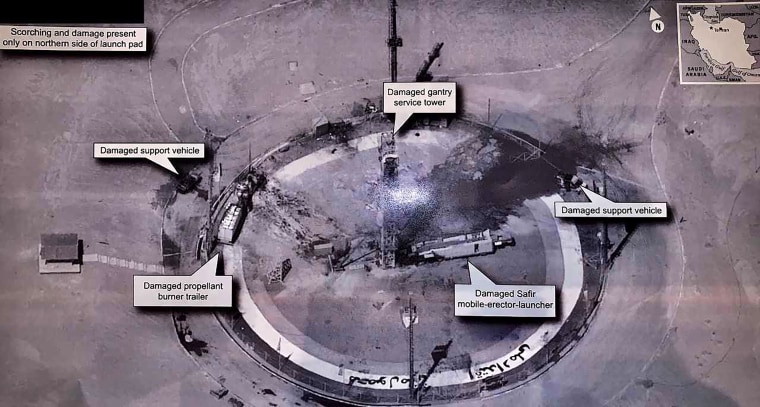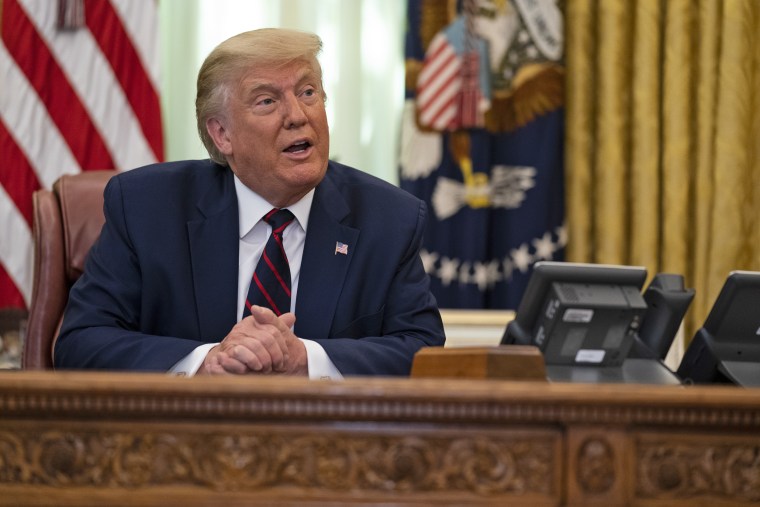Senior intelligence officials realized early on that President Donald Trump wasn’t going to read even short written summaries of his regular intelligence briefings. So the CIA officers who prepared the briefings made sure they came to the Oval Office laden with striking images, pared-down charts and slick graphics designed to grab the president’s fleeting interest, several officials familiar with the briefings told NBC News.
“To secure his attention, you had to use images and catchy headlines, even better if they had his name in them,” said Doug London, a former CIA officer who helped assemble the briefing material.
On Aug. 30, 2019, top spies learned the dangers of that approach. What unfolded that day became an infamous moment in the Trump presidency — one that former intelligence officials say perfectly illustrated his approach to dealing with state secrets. A former senior intelligence official with firsthand knowledge told NBC News that Trump did indeed tweet a highly classified image taken by a secret spy satellite, as many experts suspected at the time. And in doing so, the official and others said, Trump gave U.S. adversaries keen insights into the U.S. capabilities to spy from above.
“The president tweeted a picture of an Iranian missile launch site that showed a failed ICBM test launch that everybody acknowledged was a highly classified picture taken from space,” former national security adviser John Bolton, who was in Poland when it happened, told NBC News Monday. “He tweeted it out, and that of course declassified it by definition, but also showed what could happen when such a picture, even on a Twitter attachment, was then able to be analyzed by foreign intelligence services.”
Bolton and others familiar with it say the episode is emblematic of a mindset in which Trump or people close to him thought it was permissible to bring and store what the FBI says are highly classified documents to his compound in Mar-a-Lago.

“He spent no time understanding what made something a secret and what we protected,” a second former senior intelligence official said.
The former senior official directly familiar with the matter explained to NBC News that the president’s intelligence briefing that day included a photo from one of the America’s premier spy satellites — an image with resolution far superior to anything on the commercial market. The photo showed the aftermath of a catastrophic failure of an Iranian rocket launch.
“We had this image of the Iranian missile blown up, and it was exquisite intelligence, and he didn’t even wait,” the former official said. “As soon as we showed him, he said, ‘Hey, I’m tweeting this.’”
The official said CIA Director Gina Haspel and Director of National Intelligence Joseph Maguire tried to talk Trump out of doing it, noting that the U.S. spent billions of dollars developing capabilities to capture images from space, and told Trump, “You can’t do this. If you put this out, they’re going understand what our capability is.”
But the former official said Trump was unmoved.
“He said, 'Look, I’m the president, I can declassify anything,'” the official said.
Trump was told he was correct, but the intelligence officials asked Trump to wait, so they could provide the same image with less resolution, the official said.
Charles Kupperman, Bolton's deputy, and Vice President Mike Pence were also in the briefing, the former official said.
Pence, Haspel and Maguire all declined to comment. Kupperman confirmed his presence but otherwise declined to comment. Former President Trump’s office did not respond to a request for comment.
Presidents have declassified satellite photos in the past, as when President John Kennedy released photographs of Soviet missile sites during the Cuban Missile Crisis in 1962. But in that and other cases, the government went through a process to make sure no sources or methods were exposed.
The satellite photo wasn’t the only instance in which Trump was accused of releasing classified information.
As NBC News reported at the time, Trump in May 2017 told the Russian foreign minister and the Russian ambassador in the Oval Office that the Islamic State had used stolen airport security equipment to test a bomb that could be hidden in electronic devices and slipped undetected into an airplane cabin, the officials said. And he named the city in ISIS-held Syria where the intelligence was gathered, the officials added.
After the Iran photo incident, the former official said, senior intelligence officials resolved never again to bring highly classified images to the Oval Office.
Bolton, the former national security adviser, and London, the former CIA officer, said Trump would ask for highly classified images, charts or other documents.
“The president had a habit of asking to retain sensitive documents and from time to time, he did that and we didn’t know what happened to them,” Bolton said. “And it was always a concern, because he didn’t really fully understand the risks to sources and methods and other dangers of revealing classified information that it might get out to the wrong people.”
London said, “If he decided he liked something he saw, you would have to wrestle it back.”
To counter that, London said, briefers would use images blown up to the size of posters so Trump could not take them.
Another former senior intelligence official said Trump “didn’t behave as if he felt an obligation to protect secrets. He didn’t seem to understand.”
Mark Zaid, a lawyer who handles cases involving intelligence officers and classified information, told NBC News that Trump alone could not have been responsible for all the classified material that found its way to Mar-a-Lago.
“I don’t think anyone realistically thinks that Donald Trump took the documents off of his desk, pack them in a U-Haul box, put them on the helicopter, picked it up off the helicopter, put it in Mar-a-Lago,” he said. “Others did it for him. There must be several other people at least, who are in the scope and eyes of the Justice Department for prosecution under the Espionage Act and other statutes.”
Editor’s note: This story originally said that, according to a source, Robert O’Brien was present for the meeting. The source was mistaken and O’Brien was not present. The story has been updated to remove the reference to O’Brien and to note that deputy national security adviser Charles Kupperman was present, which Kupperman has confirmed.

